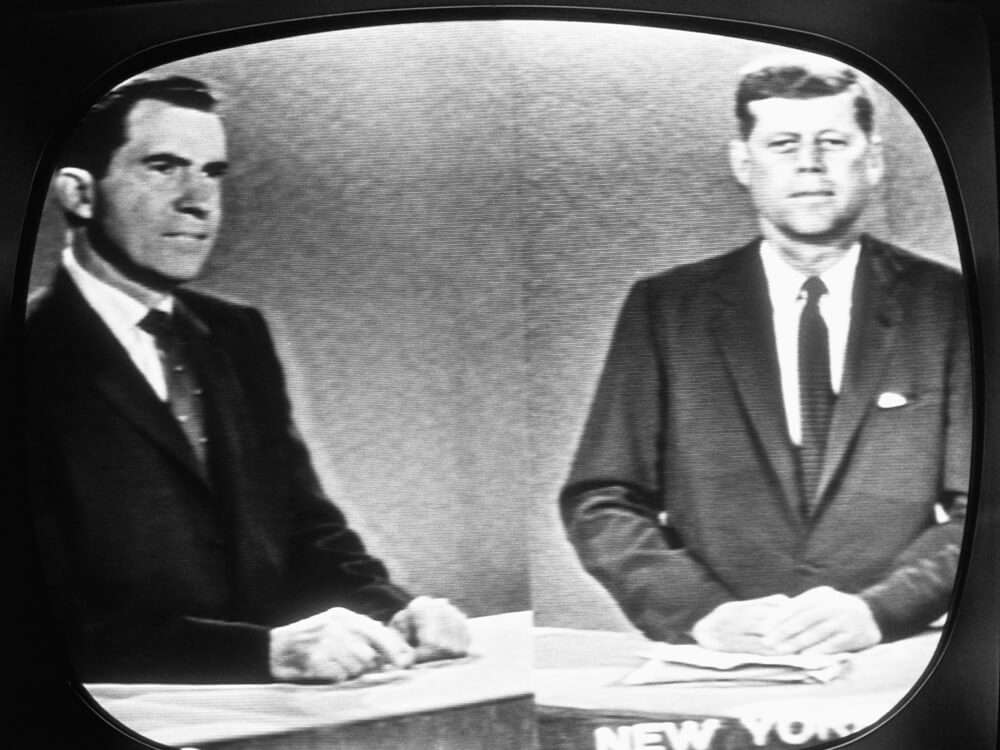Presidential candidates Richard Nixon (left) and John F. Kennedy (right) at the debate in Chicago, September 1960 (split screen)
This summer, candidates for the 2020 Democratic presidential nomination will stand on stage poised to debate before an audience and live television cameras. It’s a serious, often tense atmosphere with a lot at stake. Their mission? Clinch the support of undecided voters by answering the moderator’s questions, “thinking on their feet” while appearing calm and intelligent—and trying not to sweat. And if possible, deliver the most memorable sound bite.
Political debates are a fixture of today’s primary and general election campaigns, but they weren’t always the norm and they weren’t always televised. How did debates become central in the modern era? A key historical moment took place 150 years ago. In a series of seven debates between candidates for a U.S. Senate seat in Illinois, Abraham Lincoln challenged incumbent Stephen Douglas. The format used in 1858 may be hard to imagine. One candidate spoke for 60 minutes, the other candidate spoke for 90 minutes, and then the first candidate spoke again for the final 30 minutes. No one had held such debates before, and it would be a century before debates took center stage in presidential races.
In 1948 and 1956, presidential primary candidates verbally sparred over the radio. Television entered the picture in September 1960, when Vice President Richard M. Nixon and Massachusetts senator John F. Kennedy faced off in a live, televised general election debate in a CBS-TV studio in Chicago. More than 66 million viewers—60 percent of adults nationwide—tuned in, a record audience (it remains one of the most-watched broadcasts in U.S. television history). The Kennedy-Nixon debates changed how audiences judged candidates—relying more on their image and personality than on their policies. Well versed in foreign policy, Nixon was a proficient debater on radio. On camera, though, he appeared pale, had a “five-o’clock shadow,” and perspired under the lights. Meanwhile, Kennedy came across as young and energetic (and more handsome). Many historians credit Kennedy’s debate performance in winning one of the closest presidential elections in American history.
Years passed before the next televised presidential debates were held. Since 1976, they have been an election staple. An estimated 84 million people watched the first 2016 presidential debate between Donald Trump and Hillary Clinton. Even televised vice presidential debates are now commonplace. Besides being broadcast on television and radio, debates typically are live-streamed on the Internet.
Image credit: © World History Archive/Alamy
Related Links:
- Five Presidential Debate Moments That Altered the Course of a Presidential Race
Summary of key moments in the recent history of U.S. presidential debates.
(Source: The Conversation, September 22, 2016) - The Kennedy-Nixon Debates
Background and analysis of the first series of televised presidential debates.
(Source: History.com; accessed June 18, 2019) - Lincoln-Douglas Debates
Account of the historic 1858 debates that brought Abraham Lincoln to the national stage.
(Source: Encyclopaedia Britannica; accessed June 18, 2019 - Debate History
Summaries from the website of the official sponsor of U.S. presidential debates.
(Source: Commission on Presidential Debates; accessed June 18, 2019) - From Richard Nixon’s Five O’clock Shadow to Ronald Reagan’s Wit: The 5 Greatest Presidential TV Debate Moments of All Time
Highlights in the history of U.S. presidential debates since 1960.
(Source: The Telegraph, September 3, 2016)




